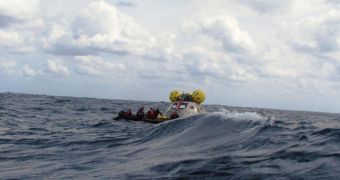Off the eastern coast of central Florida, a small and tightly secured portion of the Atlantic ocean is home to a very peculiar site. A white capsule, adorned with three orange spheres on its “nose,” floats around in the ocean, surrounded by research vessels and emergency crews, ready to step in if anything is to go wrong. The capsule is NASA's new Orion Crew Exploration Vehicle, the instrument that will take astronauts back to the Moon by 2020. It's currently getting its endurance test in the spirited waters of the oceans, after successfully passing tests inside a specially designed basin.
The goal of the recent test has been to train NASA engineers and rescue teams into retrieving the capsule under all weather conditions. It's one thing to recover it from a closed test basin, where conditions are ideal, and quite another to capture it when it floats on waves several feet high, while bouncing out of control. Undoubtedly, the astronauts that will be inside won't experience the most enjoyable sensations of their lives when oscillating on these waves, but NASA hopes that, by the time the craft becomes operational, the emergency crews will be so well prepared that their stay in the Orion will be very short.
In addition to the invaluable training, engineers will also get a glimpse of how the full-scale mock-up of the craft behaves under the most diverse sea conditions. Upon atmospheric reentry, Orion could land in the middle of a storm, or under the deep blue sky, and there's currently no way of predicting what the weather would be like a few years from now. The capsule's descent will be slowed down by an array of parachutes, but it still won't be as soft as the ones performed in the space shuttles.
“They're looking for different types of sea conditions so they can report back how the capsule behaves,” NASA spokesperson Amber Philman told SPACE from the Kennedy Space Center. If the Orion, by some accident, fell in the water nose-first, then the three orange spheres attached to the end of its cone would generate enough buoyancy to return the craft to its original position.
The American space agency hasn't performed such tests in a long time, since the 1960s, to be precise. The last time that NASA conducted capsule experiments was when the Apollo mission was being researched and investigated. Since then, the development of the shuttles led to capsule research being left hanging, as was all available money poured into the six shuttles. They became NASA's backbone, and helped the agency engage in projects such as the International Space Station (ISS).

 14 DAY TRIAL //
14 DAY TRIAL //